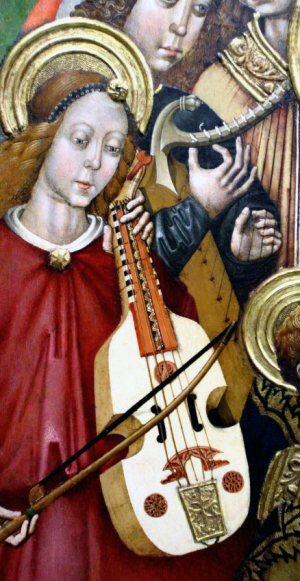The Oldest Viola da gamba in History

This was until recently thought to be the first viola da gamba to appear on a painting in history (see below). The painting was made by Valentin Montoliu around 1475-85 for the Heremitage of St. Feliu (St. Félix) in Xàtiva (Valencia, Spain). The beautiful instrument depicted shows all of the characteristics of a viol: it has the classical outline with sloping shoulders, pronounced middle bouts and deep ribs, sound holes in the shape of the letter C with three ornamental rosettes, five strings, several (four?) frets, a very rounded bridge which permits playing the strings separately, an intricately ornamented tailpiece attached with – most likely – a gut string to the base of the instrument. Only the head of this viol is actually different from those of later instruments. Instead of a carved head or a scroll on a long pegbox with the pegs coming from the sides, this instrument has a leaf-shaped pegbox, with the pegs standing vertically. The playing position and the bow hold are very much in line with the norms of later times.
The viola da gamba was invented in the last part of the fifteenth century in the culturally heterogeneous region of Valencia, Spain, a region coinhabited by Arabs, sephardic Jews and Christians, which stimulated creativity in all branches of the arts. From Valencia the viol spread throughout the Kingdom of Aragón, reaching the Islas Baleares (Mallorca, Menorca, Ibiza) and Sardinia. But Destiny had higher things in store for our infant instrument. In 1492 Rodrigo, from the Borja Family (known in Italy as the Borgia Family!), a native precisely of Xàtiva, Valencia, was elected pope. As Alexander VI he assumed the Papal Throne, bringing to Rome with him not only his army (His kingdom is of this world!) and his mistresses (not unusual for enlightened Renaissance popes…), but also his beloved consort of viols! Almost instantly the “large Spanish violas”, as they were called, became the fashionble instrument for the aristocracy all over Italy, and soon also beyond its border..
On the 6th of March of 1493 Bernardino Prospero, the Ferrarese chancellor of Isabella d’Este, witnessed the following event. On the ocassion of a ceremony celebrated in Vigevano honoring the birth of the heir of Ludovico il Moro a musical performance took place, entrusted to “those Spanish musicians which the Most Reverend Monsignor Ascanio of Rome sent”, who played “viols as big as I”.
Jambe dr Fer, Epitome Musical (Lyon 1556)
“on appelle violes celles des quelles les gentilhommes marchants et autre gens de vertu passent leur temps “
The violin assumed a position much lower on the social scale, “few play it except those who earn their living by it.”